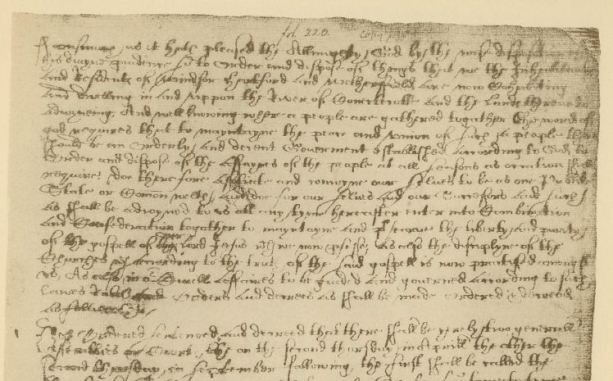The Fundamental Orders, inspired by Thomas Hooker’s sermon of May 31, 1638, provided the framework for the government of the Connecticut colony from 1639 to 1662.
For two years before the adoption of the Fundamental Orders, Windsor, Hartford and Wethersfield cooperated under a simple form of government composed of magistrates and representatives from each town, but the towns had no formal instrument of government. Roger Ludlow of Windsor, the only trained lawyer in the colony, probably drafted the Fundamental Orders, although he may have been assisted by Hartford residents John Haynes (a former Governor of the Massachusetts Bay Colony), Edward Hopkins, and John Steel. The document consisted of a preamble and 11 orders or laws. The preamble was a covenant which bound the three towns to be governed in all civil matters by the Orders. The preamble, then, was a civil equivalent of a church covenant. (The model of the Biblical covenant served as the foundation for all Puritan organizations.) The Connecticut General Court adopted the Fundamental Orders on January 14, 1639. (The colonists did not follow current conventions for marking a year and, thus, the date on the document itself is listed as 1638.)
General Court held Legislative, Executive, Judicial, and Administrative Authority
The 11 orders clearly followed the Massachusetts government model and were consistent with 17th-century trading company charters. The Orders called for the convening of general courts every April and September. At the April Court of Election, a governor and six magistrates were to be chosen. No man could serve as governor more than once every two years, a restriction that lasted until 1660. To prevent hasty, ill-considered choices, nominations for election were made at the September General Court by the deputies from each town. The governor and magistrates, who composed the nucleus for an Upper House, were to be elected by the freemen at the Court of Election. The other Orders prescribed regulations for nomination and election and set forth conditions for calling the General Court into special session. No religious test was established for voting, the Orders omitted all reference to the authority of the crown, and the General Court was given supreme authority over the towns and their inhabitants. The General Court was authorized to adopt and repeal laws, impose taxes, distribute land, apprehend and punish people for misdemeanors, and enact legislation to promote the general good. The General Court was granted, then, all legislative, executive, judicial, and administrative authority. The right to elect deputies and magistrates was, however, reserved to the freemen.
The matter of whether the Fundamental Orders of Connecticut should be considered a constitution in the modern sense, let alone honored as the first written constitution (as was once claimed), remains a matter of debate. Nevertheless, they served as the basis for government in Connecticut until 1662. They are also the reason why, in 1959, the General Assembly officially designated Connecticut as “the Constitution State.”
By Bruce P. Stark; excerpted from Connecticut History and Culture: an Historical Overview and Resource Guide for Teachers (1985), edited by David Roth.









